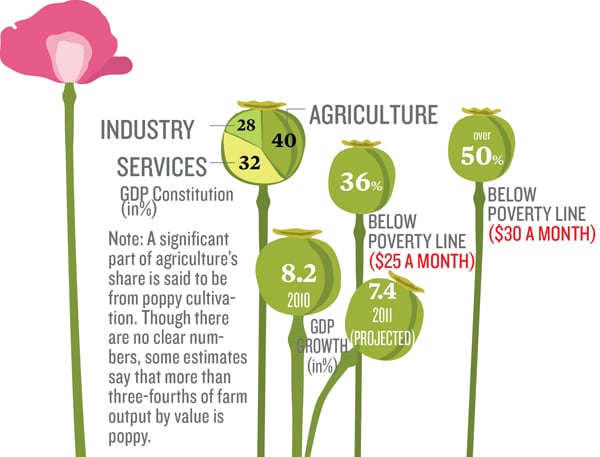
The Rebirth of Afghanistan's Banking
The country's banking system is slowly finding its feet again, but the deteriorating security situation poses a challenge
Nearly nine million Afghans are living in extreme poverty because of a lack of investment in farming, Mohammad Asif Rahimi, Afghanistan’s minister for agriculture, livestock and irrigation, said on October 16, World Food Day.
The World Bank estimates that about 36 percent of Afghans live below the poverty line or survive on less than $25 a month and nearly half the population lives on less than $30 a month. Minister Rahimi also said in the past three decades investment in agriculture had shrunk 43 percent.
Throughout 2009 and until mid-2010, the country was gripped by a price deflation. In 2009, average consumer price inflation was a negative 12.02 percent. Since then, prices have risen gradually, led by housing costs. By December 2010, the needle had swung to 12.09 percent. Afghanistan’s output grew 8.2 percent in 2010 and the International Monetary Fund (IMF) expects it to expand by 7.4 percent in 2011.

Infographic: Sameer Pawar
The central bank, Da Afghanistan Bank (DAB), missed its monetary target of 22 percent money circulation growth in 2009-10, but that hardly made any impact because of deflation. Actual money circulation grew 29 percent, the World Bank says.
The monetary policy framework of Afghanistan is designed under the IMF’s Poverty Reduction and Growth Facility programme. The banking industry had collapsed during the Taliban years and the country was practically a cash economy. Of the six state-owned banks, three were illiquid, dysfunctional and nearly insolvent, a central bank strategic paper mentions in a background note. In 2002, there were three or four versions of the local Afghani, including two issued by warlords. The IMF estimated hyper inflation in the range of 495-600 percent.
The turnaround achieved since then has been remarkable. The currency, which is now a managed float, is stable in a band of 45-50 to a dollar. There are now 17 licenced commercial banks in operation, accounting for a quarter of the GDP. The government bonds, called capital notes, market is developing and international reserves have steadily increased to over $5.5 billion in mid-May. DAB’s 182-day capital notes had a weighted average interest rate of 3.4 percent in the fourth quarter of 2010.
“There is not too much of commercial lending because of lack of industry, but micro-finance is doing very well,” says Hafizullah Walirahimi, president of Fair Trade in the ministry of commerce and industry. Some industries like construction are gathering momentum as incomes are rising, albeit slowly.
Over the past few months, however, worsening security has cast a shadow on macroeconomic development. In the upcoming Bonn Conference, if the international community pledges prolonged military and economic support, there is a possibility of the economy improving significantly. Increased economic activity itself may present incentives to sustain peace in this country where no one below 30 has ever known what it is.





